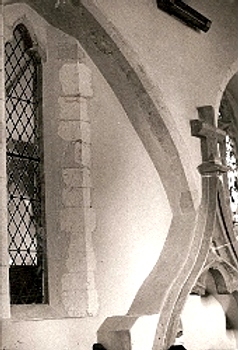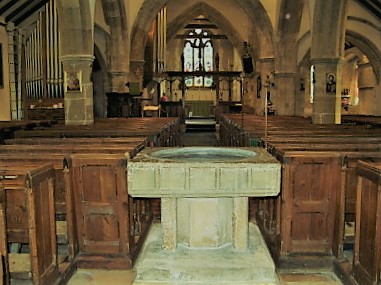Lancing – St James
The church is built with an axial tower and most appears to date from c1300, a very late date for this type of plan. However, there is evidence of earlier work, some possibly pre-Conquest and some late C12, and there was work in the early C17.
As with so many Sussex villages along the coast, Lancing lies away from the coast, with the parish church (St James) on the main street.
The church is mostly of c1300, an unusually late date for its axial tower plan, but there is evidence of a C12 predecessor and it would be tempting to suggest that the plan was retained from this, as the form was more widely current in the C12. However, Godfrey argued in favour of a C12 church with a west tower, noting what looks like an old south quoin at clerestory level (SAC 81 (1940) p118) and vertically arranged stones at the west end inside. Some doubt was cast on this interpretation during repairs in 1994, when more such quoins were uncovered on both sides of the west wall, suggesting that there had had been an earlier, narrower church, which was possibly pre-Conquest (church website).
Other traces of the C12 church include the renewed late C12 west doorway, which could be reset or have belonged to the presumed tower. Though round-headed, its mouldings are gothic. The thicker adjacent walling has herringbone masonry and could equally remain from a tower. The round-headed, roll-moulded south doorway, set in a later porch, is also late C12, with nook-shafts and stiff-leaf capitals and the walling of the later south aisle appears to incorporate earlier work, e g a fragment of C12 chevron moulding by the north west corner. Exposed herringbone masonry in the east wall of the otherwise rendered chancel is no later than the C12, giving the latest possible date for the present length of the chancel. Further support for this dating comes from a string-course and billetwork inside. Such a long chancel would be exceptional for the C12 unless the axial tower plan, which could stretch out the church unduly, already existed. This would be another argument against Godfrey’s interpretation.
The only C13 work is a lancet in the south aisle, likely to be reset if old. The reason for the rebuilding around 1300 is not known. The larger arches possible by that time remedied one defect of earlier axial tower churches, an over-emphasised division into distinct compartments. The tall three-bay nave arcades have octagonal piers and their date is confirmed by the east responds, where the heads emerge from above the abaci; three of the four tower arches share this feature, though the heads have three orders. On the soffit of the western one is a groove into which the boards of the tympanum behind the rood fitted. The aisles extend either side of the tower and its fully developed north and south arches lead Godfrey to suggest there were transepts (ibid) and he sees the eastern arches of the nave aisles as further evidence. Their detail is C14 like the others and they are set in larger arches and at a slight angle, but they were more probably intended to support the tower. At Etchingham, East Sussex, which is mid-C14 and thus appreciably later, the tower stands on four arches, but it is quite clear that no transepts were intended, and the same is likely to apply here. Less easy to explain is that the aisles either side of the tower differ from with the rest, with renewed windows of C15 pattern. If they were rebuilt then, the presence of the side-arches show that they were there from the first. The north side has been truncated for a stair.
The more steeply pointed eastern tower arch springs from the abaci, but must be of the same date as the others and the crownpost nave roof is probably contemporary. So is most detail of the aisles and chancel, though renewed. The aisles have hollow-chamfered doorways, trefoil lancets and square-headed windows with pierced spandrels. Adelaide Tracy (III p9) (1852) and Nibbs (c1851) show little has changed. The chancel has trefoil-headed lowsides each side, set inside in tall wall-arches, of which the north one, now opening into a vestry, is cut into by a large ogee-shaped tomb-recess which is little later. The other has a low sill for sedilia (see below). Further east, two windows have spherical triangles in the heads. The Burrell Collection drawing (1789) shows only one, as well as intersecting tracery in the east window.
Apart, possibly, from the eastern parts of the aisles, already discussed, there is no C15 work and the date of the plain tower is uncertain. Though started in the C14, it cannot be in its original state. The bell-openings, immediately under a heavy pyramid roof, are undivided, though the east one shows traces of mullions. Above the eastern tower arch inside an inscription records repairs in 1618 and most work is likely to date from then. The churchwardens’ presentments state in 1621 that ‘our church and tower was fallen downe, and both bin a building uppe these many years and is not yet finished’ (SRS 49 p17) and in 1626 that the chancel was ‘in great decay’ (ibid p122). This may suggest the inscription of 1618 dates from part-way through a longer process. Indeed, the position of the bell-openings could suggest that the tower was never completed. A further alteration at this time may have been the mullioned clerestory visible in the Burrell drawing (now replaced).
Names and dates for C19 restoration are few. Little identifiable survives from a re-seating and repairs in 1827 by W Ranger (ICBS). The large plain and round-headed west window shown by Nibbs and Adelaide Tracy could well have dated from this time, but it has been replaced by one with geometrical tracery. Other changes include quatrefoils in the clerestory and by 1875 £548 5s 8d had been spent (PP 125). The dates and authorship of the obviously C19 chancel roof and most of the stonework are not known, though the aisle roofs were repaired (or more accurately replaced) in 1888 (CDK 1888 pt 2 p137). As only £100 was spent then and that included other work, that can hardly be the date of the windows, though two ancient windows were found in the chancel during the work (ibid).
The modest extension was added in 2017 and was designed by R Andrews of Carden and Godfrey (BE(W) p469).
Fittings
Font: C12. A shallow square bowl with incised square panels instead of arcading. This appears original though there is none other like it and the octagonal stem and corner-shafts are not old.
Glass:
1. (East and west windows) 1859 and attributed to Heaton, Butler and Bayne (www.stainedglassrecords.org retrieved on 11/3/2013).
2. (East end of south aisle and chancel north window) 1866. In an obviously pre-Raphaelite idiom, though no designer has been identified for certain, these have also been attributed to Heaton, Butler and Bayne (ibid). There are signs of deterioration.
3. (South aisle, third window) J Powell and Sons, designed by G Hutchinson, 1892 (Order book).
4. (North aisle, first window) Ward and Hughes, 1885 (signed).
Sedilia: In the sill of the south lowside in the chancel; the splays above are supported on miniature squinches. That on the east side has a stop.
My thanks to Josie Campbell for the colour photographs.





